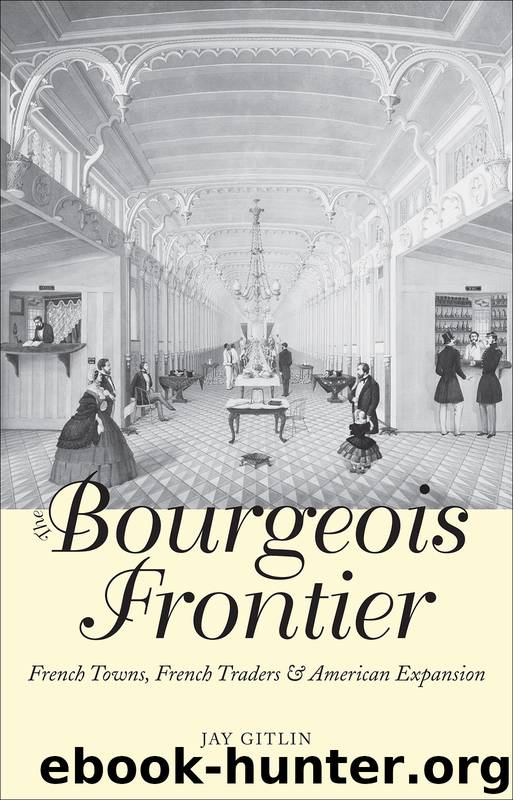Bourgeois Frontier by Jay Gitlin

Author:Jay Gitlin
Language: eng
Format: epub, mobi
Publisher: Yale University Press
Published: 2010-10-12T16:00:00+00:00
Mrs. Ramsay Crooks. The marriage of Marianne Pelagie “Emilie” Pratte (1806-1863), daughter of Bernard Pratte and Emilie Labbadie, to Ramsay Crooks, right-hand man of John Jacob Astor, in 1825 facilitated the business arrangement between the French Creole family firm in St. Louis and the American Fur Company in New York City. The couple raised their family in New York. Emilie’s sister Thérèse also lived in New York, having married a native of France, Louis Peugnet, who with his brother established a fashionable private school in the city. Photo courtesy of the Milwaukee County Historical Society.
The consortium of second-generation cousins lasted for almost two decades and had served the family well as both a vehicle for the accumulation of wealth and a training ground for countless family members. By the 1840s, many third-generation cousins had already served their apprenticeships and were, as we saw in Chapter 5, managing outfits and departments in Kansas, present-day Oklahoma, and the Missouri River valley. Indeed, it seems that the Chouteau interests expanded as fast as the frontier itself. The West provided a vast field of opportunities in both the fur trade and land speculation. No group or family had a better position from which to view the potential investment possibilities.
While Pierre Chouteau Sr.'s sons entered the fur-trade business, Auguste—who had always shown more interest in real estate — must have encouraged several of his sons to pursue the business of land acquisition. Cerré Chouteau, Auguste’s second son, returned to St. Louis from Indian country after his father’s death in 1829 to manage his milling operation.39 Cerré's younger brother Henri, who was clearly Auguste’s successor, served as the county clerk and recorder for many years.40 In 1842, he took his son-in-law, Neree Vallé, on as a partner. These partners accumulated land at sheriffs’ sales all over Illinois and Missouri and entered the iron business. After Henri’s death, Vallé began purchasing mining property in Colorado.41 In the 1880s, J. Oilman Chouteau, Henri’s son, was advising his nephew Azby Chouteau on the acquisition of lands in Dakota Territory. Azby, who owned a substantial amount of railroad bonds, was careful to purchase land along the planned route. He also operated a ranch near Deadwood in Dakota Territory.42 The West, the Chouteau family, and the wealth of the latter seemed to be limitless.
How can we account for the astounding success of this family? Part of the answer surely lies with their devotion to reinvestment in their children. The correspondence of four generations of Chouteau kin includes hundreds of letters written between parents and children, uncles and nieces, aunts and nephews. The thematic continuity of these letters is striking, and the sentiments are touching. In 1800, Auguste Chouteau wrote the following to his brother-in-law, Judge Pierre-Louis Panet of Montreal, to whom he was about to entrust his oldest son:
The education of my children is the most important thing for a father, since it concerns their happiness or unhappiness, and, finding myself living in a country where it is impossible to get
Download
This site does not store any files on its server. We only index and link to content provided by other sites. Please contact the content providers to delete copyright contents if any and email us, we'll remove relevant links or contents immediately.
| African Americans | Civil War |
| Colonial Period | Immigrants |
| Revolution & Founding | State & Local |
Cat's cradle by Kurt Vonnegut(15189)
Pimp by Iceberg Slim(14398)
4 3 2 1: A Novel by Paul Auster(12289)
Underground: A Human History of the Worlds Beneath Our Feet by Will Hunt(12027)
The Radium Girls by Kate Moore(11930)
Wiseguy by Nicholas Pileggi(5674)
Perfect Rhythm by Jae(5326)
American History Stories, Volume III (Yesterday's Classics) by Pratt Mara L(5257)
The Fire Next Time by James Baldwin(5250)
Paper Towns by Green John(5092)
Pale Blue Dot by Carl Sagan(4914)
A Higher Loyalty: Truth, Lies, and Leadership by James Comey(4851)
The Mayflower and the Pilgrims' New World by Nathaniel Philbrick(4428)
The Doomsday Machine by Daniel Ellsberg(4420)
Killers of the Flower Moon: The Osage Murders and the Birth of the FBI by David Grann(4387)
The Sympathizer by Viet Thanh Nguyen(4307)
Too Much and Not the Mood by Durga Chew-Bose(4278)
The Borden Murders by Sarah Miller(4251)
Sticky Fingers by Joe Hagan(4105)
